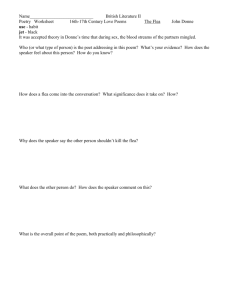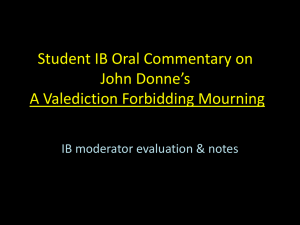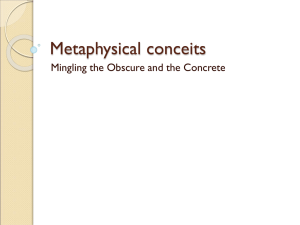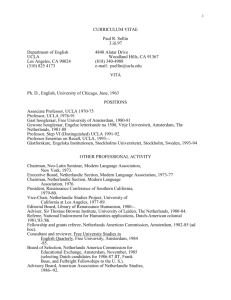HUMAN 120, Spring, 2013 Week 8 Class Notes, page Prof
advertisement
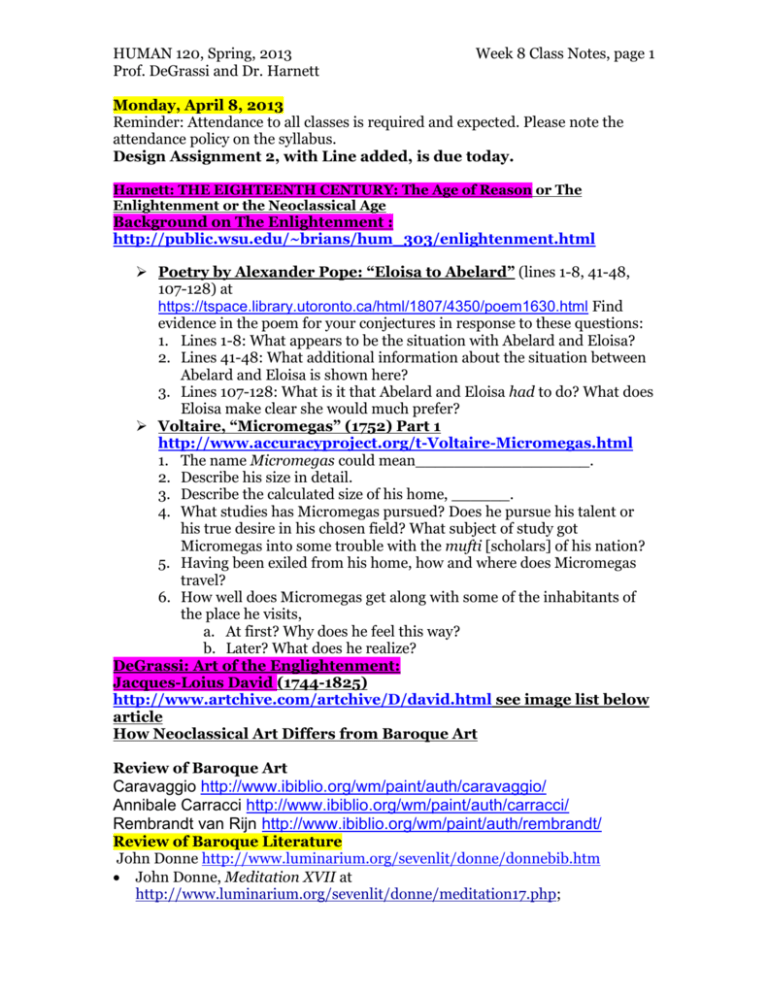
HUMAN 120, Spring, 2013 Prof. DeGrassi and Dr. Harnett Week 8 Class Notes, page 1 Monday, April 8, 2013 Reminder: Attendance to all classes is required and expected. Please note the attendance policy on the syllabus. Design Assignment 2, with Line added, is due today. Harnett: THE EIGHTEENTH CENTURY: The Age of Reason or The Enlightenment or the Neoclassical Age Background on The Enlightenment : http://public.wsu.edu/~brians/hum_303/enlightenment.html Poetry by Alexander Pope: “Eloisa to Abelard” (lines 1-8, 41-48, 107-128) at https://tspace.library.utoronto.ca/html/1807/4350/poem1630.html Find evidence in the poem for your conjectures in response to these questions: 1. Lines 1-8: What appears to be the situation with Abelard and Eloisa? 2. Lines 41-48: What additional information about the situation between Abelard and Eloisa is shown here? 3. Lines 107-128: What is it that Abelard and Eloisa had to do? What does Eloisa make clear she would much prefer? Voltaire, “Micromegas” (1752) Part 1 http://www.accuracyproject.org/t-Voltaire-Micromegas.html 1. The name Micromegas could mean__________________. 2. Describe his size in detail. 3. Describe the calculated size of his home, ______. 4. What studies has Micromegas pursued? Does he pursue his talent or his true desire in his chosen field? What subject of study got Micromegas into some trouble with the mufti [scholars] of his nation? 5. Having been exiled from his home, how and where does Micromegas travel? 6. How well does Micromegas get along with some of the inhabitants of the place he visits, a. At first? Why does he feel this way? b. Later? What does he realize? DeGrassi: Art of the Englightenment: Jacques-Loius David (1744-1825) http://www.artchive.com/artchive/D/david.html see image list below article How Neoclassical Art Differs from Baroque Art Review of Baroque Art Caravaggio http://www.ibiblio.org/wm/paint/auth/caravaggio/ Annibale Carracci http://www.ibiblio.org/wm/paint/auth/carracci/ Rembrandt van Rijn http://www.ibiblio.org/wm/paint/auth/rembrandt/ Review of Baroque Literature John Donne http://www.luminarium.org/sevenlit/donne/donnebib.htm John Donne, Meditation XVII at http://www.luminarium.org/sevenlit/donne/meditation17.php; HUMAN 120, Spring, 2013 Prof. DeGrassi and Dr. Harnett Week 8 Class Notes, page 2 o What messages does Donne convey in the Meditation? Note statements about awareness responsibility humanity affliction and misery other topics? o Focus on the famous “No man is an island” section: what does this section say and/or imply? Donne, Sermon 12, parts 1-4 at http://www.msgr.ca/msgr3/john_donne_sermon_08.htm (part 1): the infinite nature of God’s presence and love of all creation, http://www.msgr.ca/msgr3/john_donne_sermon_08b.htm (part 2): the mystery of creation—God making something out of nothing, http://www.msgr.ca/msgr3/john_donne_sermon_08c.htm (part 3): glory of man vs. glory of God, and http://www.msgr.ca/msgr-3/john_donne_sermon_08d.htm (part 4): knowledge of man vs. knowledge God has. o John Milton (1608-1674) “On his Deceased Wife” (1658) http://www.luminarium.org/sevenlit/milton/sonnet23.htm 1. Explain the reference to Alcestis in Line 2. 2. How had the speaker’s wife died? 3. What does the speaker of the poem feel as he sees his deceased wife appear to him again? 4. What happens just as his wife is about to embrace him? 5. What message about love do you derive from this incident described in the poem? Note: By most accounts, Milton developed glaucoma and was completely blind by the age of 43 in 1654. But he came to terms with his condition, and was able to write poems by dictating them to amanuenses (helpers). One of these helpers was the major English poet Andrew Marvell, who also spoke for him in his place in Parliament. Milton held several important government positions, and also got himself into trouble through his writings. One of his books was publicly burned as a reprimand and a warning. “On His Blindness” (1655) at http://www.luminarium.org/sevenlit/milton/sonnet19.htm 1. What is the problem that the speaker of the poem faces? 2. How does the speaker come to terms with this problem, as he says later in the poem? John Milton, Paradise Lost excerpts from Book 1, [27-49—overview] lines 84-109; 242-270: http://www.dartmouth.edu/~milton/reading_room/pl/book_1/index.shtml o What makes Satan a complex dramatic character? o How is he portrayed in a way that might even make readers sympathetic to him in some ways? HUMAN 120, Spring, 2013 Prof. DeGrassi and Dr. Harnett Week 8 Class Notes, page 3 o Illustrations by various artists (John B. Medina did the book’s 4th edition and 1st folio): http://www.paradiselost.org/4-storiespictures.html o Illustrations by Doré (19th Century) at http://www.danshort.com/pl/ Luis Gongora (Spain) Some Qualities of Baroque Era creations: Period roughly early 1500s to the French Revolution (1789) Elaborate, ornate compositions, rich colors, even excessively so, including metaphysical conceits in literature Insights and influences from scientific advances, such as optics and the human anatomy, psychology and mathematical precision, creating order in the product o Tactile quality of art to show various surfaces, textures Theatrical lighting and settings Dramatic situations, expressing emotion Counterpoint: one theme or rhythm balanced against another For Next Time: Exam 3 is next time (Wednesday, April 10). It will have two parts: o Art: describe a painting from the Baroque Era in some detail. What scene is shown, what does it mean, what story is involved, such as a religious story, etc.? Show what people are doing, what appears to have happened, etc. Describe uses of colors, lighting effects, underpainting, etc. and other techniques and effects that the artist created as the painting was designed and accomplished. Then explain specific qualities of it that characterize it as Baroque. Be as thorough with this part as possible. o Literature: Interpret meanings in a poem we have discussed from the Baroque Era (the Later Renaissance in England). Support your interpretation with specific quotes and citations of the poem itself as evidence. Show what makes this poem characteristic of the Baroque Era, again making specific references to the poem in the form of quotations and citations that you select and explain. As you analyze a work of literature, point out particular features, then explain how those features are evident. For instance, if you say that a work is complex to the point of being ornate, show exactly what about it is ornate—provide a quote and explain how that quote demonstrates ornateness. Some Reminders and Rules: HUMAN 120, Spring, 2013 Prof. DeGrassi and Dr. Harnett Week 8 Class Notes, page 4 Notes are allowed for the exam. On the other hand, you must follow the GCC Academic Honesty Policy, meaning that you must do your own work. You should not use anything pre-written as an essay. You should not give or receive any kind of information with anyone else in class. You should not use a device such as a phone or refer to materials other than your notes and the works themselves. If you have any questions or problems, during the exam, just ask us. Wednesday, April 10, 2013 Exam 3 in class. For Monday, April 22: Read Johann Wolfgang Von Goethe, Faust (selections/excerpt) begin at http://www.gutenberg.org/files/14591/14591-h/14591-h.htm Read these selected scenes: “Prelude at the Theatre” “The Prologue in Heaven” “Night” III-IV. “In the Study” VI. “Witches’ Kitchen” XVI. “Martha’s Garden” XX. “Cathedral” XXV. “Dungeon” ** Annotations due on these excerpts, 1 or more Fact and corresponding Insight from each of the 8 selected scenes, plus 2 other annotations from any scenes.


